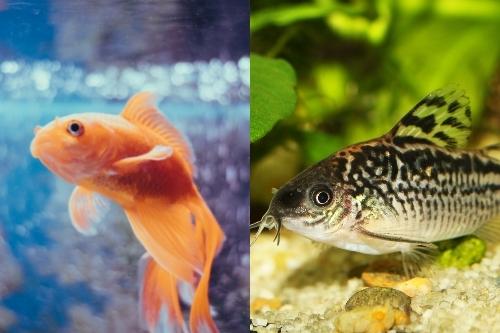Corydoras are catfish that can be located in almost every fish store and are common in tropical aquariums. Corydoras are modest, with a length ranging from 2 to 5 inches.
There are 161 varieties of Corydoras catfish, although the bronze cory, bandit cory, panda cory, peppered cory, julii cory, and three stripe cory are the most frequent. These adorable tiny fish are from South America. They reside in slow-moving streams and densely vegetated rivers there.
Wild Corydoras catfish eat little pieces of food found in the substrate. They spend a lot of time eating, sifting through the muck and sand with their whiskery barbels.
Corys, like all types of catfish, are bottom scavengers, collecting unconsumed food pieces and other detritus from the bottom of the tank. This makes them great tank mates for betta fish, who love to stay near the water’s surface.
Corydoras catfish are available in a variety of hues and patterns. This, however, will have no effect on their demeanor. The color will usually be brown, gray, or black. However, don’t be shocked if you notice different colors on your corydoras.
Table of Contents
Water Conditions for Your Corydora and Betta
If you want to keep Corydoras catfish in your aquarium, ensure the water conditions are favorable for them. They are sturdy fish, but if the temp or pH becomes too high or low, they may become stressed over time.
A pH of 7.0-7.8 is required for corydora catfish. It’s worth noting that bettas prefer a pH of 7.0, so as long as you can maintain your water as near to that number as possible, your corydoras and bettas will be OK.
The only issue is that bettas can live in slightly acidic settings but not in alkaline ones. As a result, you must maintain a constant pH of 7.0.
Regarding the water temperature, the ideal temperature for a betta is 78°F, while a corydora’s optimum temperature of the water is 70-78°F. Maintain the temperature of the water as close to 78°F as possible, but don’t sweat if it fluctuates a few degrees.
Habitat of the Corydoras and Betta
Bettas and corydoras catfish prefer similar environments, so you may set up your tank to fit them both. Corydoras, like bettas, don’t require a lot of space and may live in tanks as little as 10 gallons.
You have to take into account certain aspects:
Decoration
When it refers to tank decoration, you must use a lot of real plants. This will give the aquarium a more great and natural feel, and corydoras and bettas will enjoy them. You must also think about using driftwood and rocks as decorations. The idea is to provide your fish with a lot of places to hide.
Both your corydoras and betta will want to hide from time to time, so make sure you have hiding spots for them. That is absolutely critical for all species and is sometimes disregarded.
Substrate
Ensure your corydoras are growing in a suitable medium. Sand or tiny gravel must be used.
If you’re going to use gravel, make absolutely sure it’s not too rough or jagged, or your corydoras’ barbels will be damaged.
Tank Cover
Always keep an eye on your tank and ensure it’s covered. If you haven’t noticed, your betta will frequently attempt to leap out of the aquarium. They move, jumping from pond to pond in nature, seeking new food, territory, and partners. Your corydoras, like your bettas, will also try to jump out of the aquarium.
Corydoras are known to swim to the tank’s surface in search of food. Ensure you’ve totally covered the top of your aquarium before introducing bettas or corydoras.
The temperament of These Fish
Whether you’re a beginner or a seasoned fishkeeper, you’re aware that bettas don’t have the best demeanor. This must be taken into account while looking for fish that will make good tank mates.
Bettas prefer to stay around the top and middle of your aquarium, whilst corydoras prefer to remain close to the bottom. So you wouldn’t have to be concerned regarding your betta harming your corydoras since they are unlikely to harm it. When your corydoras goes up to eat, this is the only moment the situation could get complicated.
Corydoras are calm fish who will never attack your betta. They are quite friendly, particularly when surrounded by their own species.
If you maintain corydoras in groups of six or more, you’ll notice that they eat from the tank’s substrate. That isn’t to say you can’t keep them alone, but keeping them in groups will ensure that they are as happy as possible.
Healthy Corydoras
Before you go out and buy some corydoras to introduce to your betta, ensure you choose the best ones. If you choose weak, sick, or unhealthy corydoras, your entire tank could become infected with disease putting your betta at risk.

